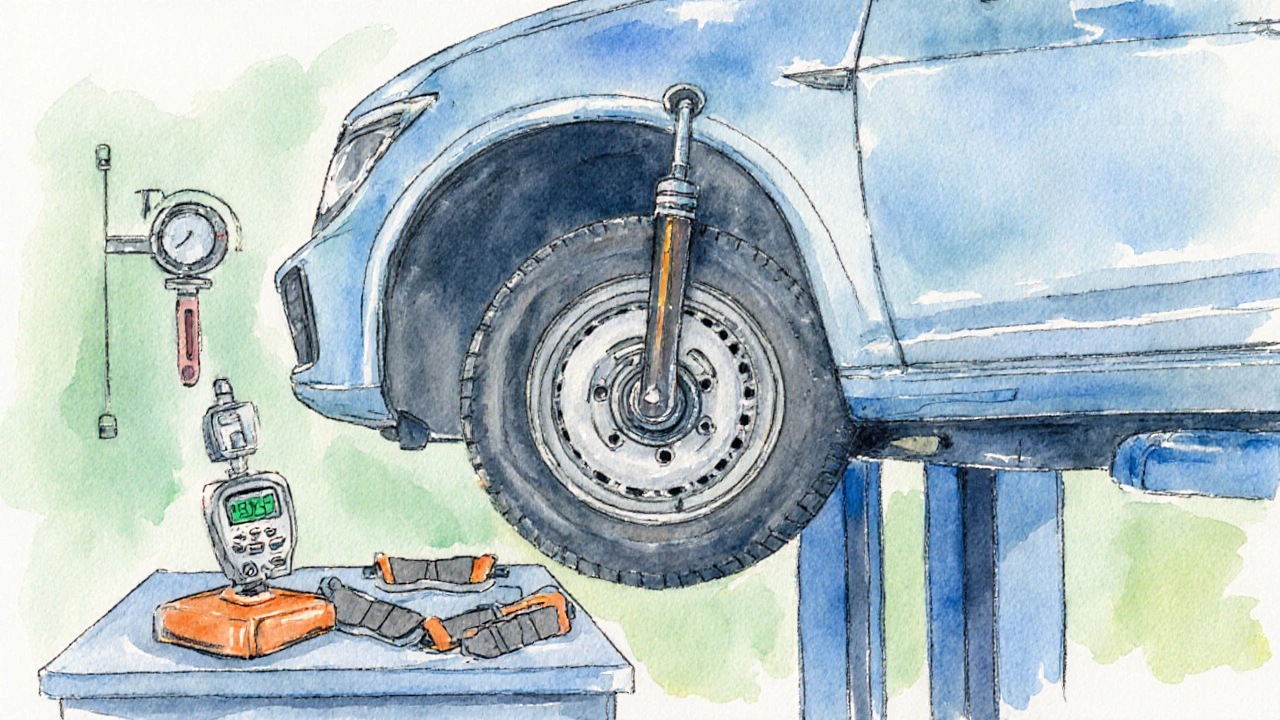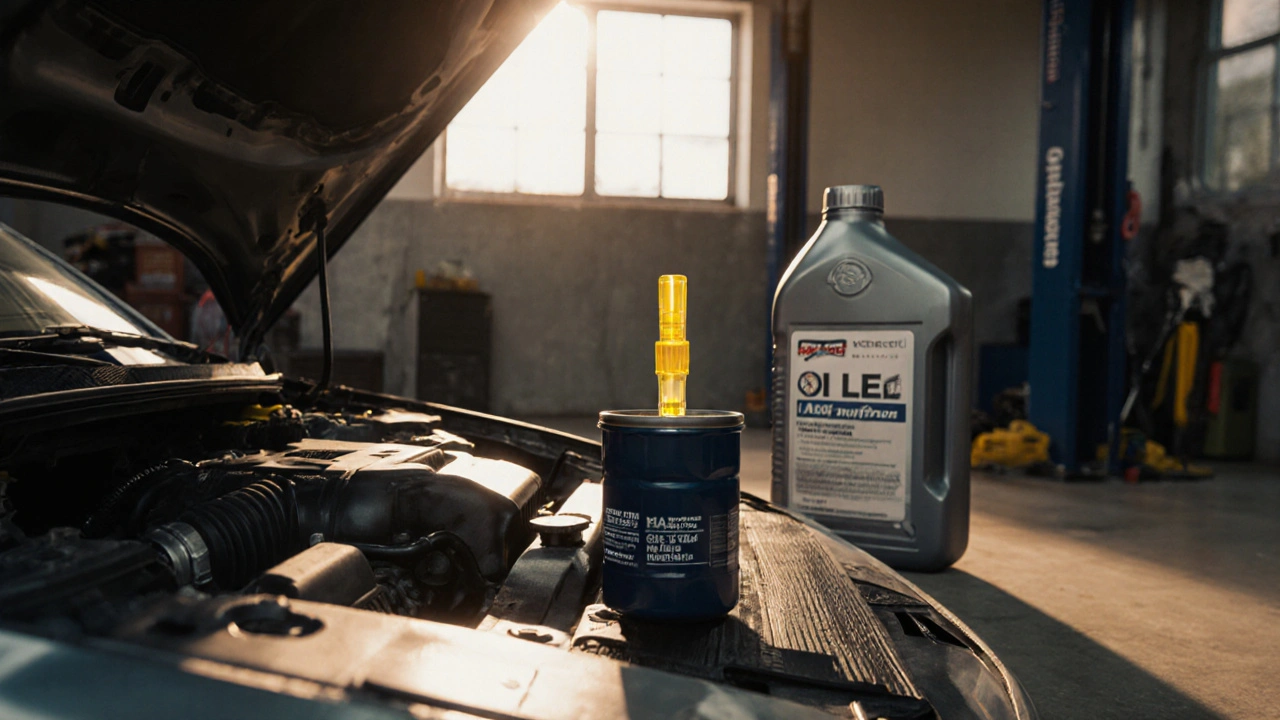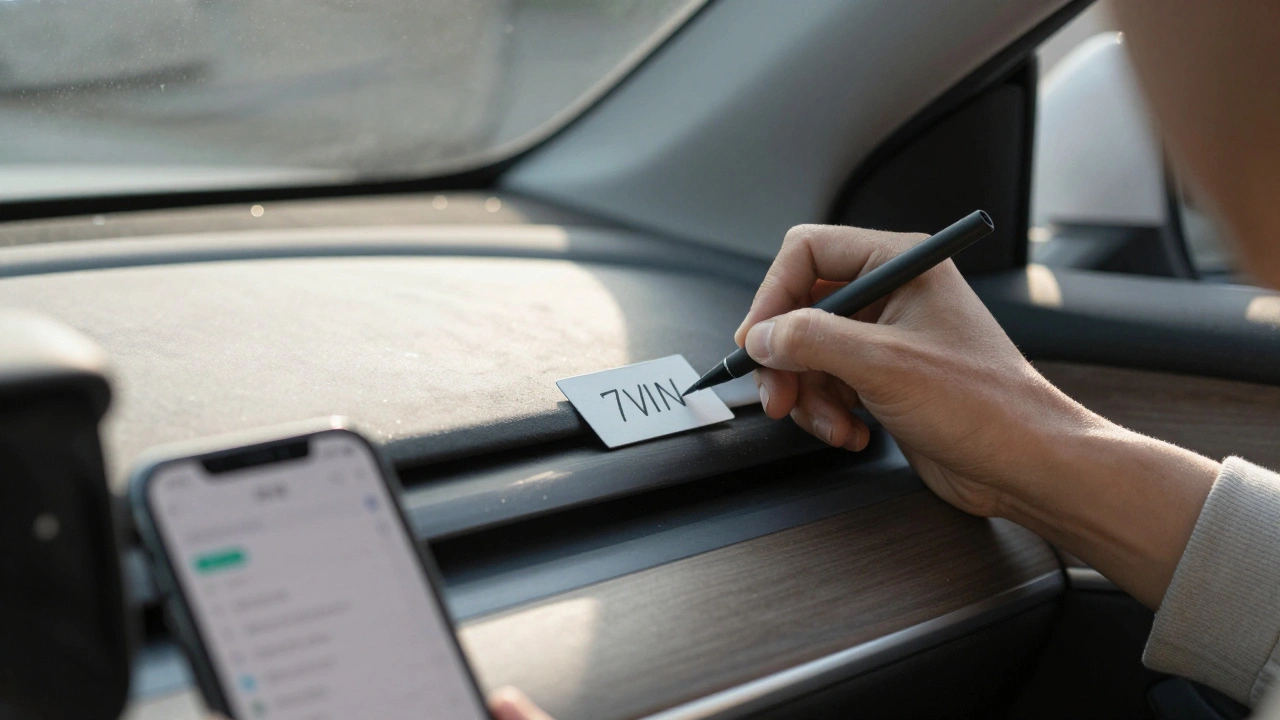Car Maintenance Calculator
Quick Takeaways
- Follow a simple schedule for oil, filter, and fluid changes.
- Check tire pressure and tread weekly to avoid premature wear.
- Inspect battery terminals and cleaning them can add years to battery life.
- Rotate tires every 5,000mi and replace brake pads before they hit the metal indicator.
- Keep a printed checklist handy - it saves time and money.
Keeping your car on the road without costly surprises boils down to one thing: car parts maintenance. Whether you drive a daily commuter or a weekend cruiser, the same basic care routine applies. Below you’ll find the parts that wear out fastest, the practical steps to keep them healthy, and a quick‑reference table that makes choosing the right products a breeze.
Core Parts That Need Your Attention
Not every component in a vehicle demands a monthly check‑up, but these eight are the big players when it comes to longevity.
When it comes to engine oil is a lubricant that reduces friction inside the engine and helps dissipate heat, a dirty or low‑grade oil will quickly eat away at pistons and bearings.
The air filter is a screen that traps dust, pollen, and debris before they reach the engine. A clogged filter forces the engine to work harder, hurting fuel efficiency.
A battery is a chemical cell that stores electrical energy for the starter motor and electronics. Corroded terminals or a failing cell can leave you stranded.
The tires are rubber assemblies that provide traction, absorb shocks, and support the vehicle’s weight. Uneven wear or low pressure reduces grip and fuel economy.
When the brake pads are worn down, the metal backing plate contacts the rotor, causing squeal and damaging the brake system.
Spark plugs are electrodes that ignite the air‑fuel mixture in each cylinder. Fouled plugs cause misfires, rough idle, and lower power.
The timing belt is a reinforced rubber belt that synchronizes the camshaft and crankshaft. If it snaps, engine damage can be catastrophic.
Finally, the cooling system fluid (coolant) transfers heat away from the engine and prevents freezing. Low or old coolant leads to overheating.

Practical Maintenance Tips You Can Do at Home
- Check and change engine oil regularly. Use the dipstick weekly; the oil level should sit between the low and full marks. If it looks dark or gritty, schedule an oil change. For most 2024‑2025 models, 5,000-7,500mi or every six months is ideal.
- Choose the oil grade recommended in the owner’s manual (e.g., 5W‑30 synthetic).
- When swapping, replace the oil filter at the same time - a cheap filter can let debris slip through.
- Replace the air filter every 12,000mi or sooner in dusty environments. A quick visual check: hold the filter up to the light; if you can see through the paper, it’s time for a new one.
- Inspect the battery. Look for white crust on terminals - that’s corrosion. Clean with a mixture of baking soda and water, then tighten the clamps. Test the voltage with a multimeter; a healthy 12‑volt battery should read >12.6V at rest.
- If the voltage drops below 12.0V after a short drive, the battery may need replacement.
- Maintain tire health. Use a digital gauge to keep pressure at the manufacturer’s recommended PSI (often 32‑35psi). Rotate tires every 5,000mi to even out wear patterns. Check tread depth with a penny - if you can see the top of Washington’s head, replace the tire.
- Don’t forget the spare; a neglected spare can be useless when you need it most.
- Watch brake pads. Listen for a high‑pitched squeal - most pads have a wear indicator that makes noise when metal contacts the rotor. Measure pad thickness; replace when it’s under 3mm.
- After replacement, burn‑in the brakes gently for 10‑15minutes to lay down an even layer of pad material.
- Change spark plugs every 30,000-60,000mi depending on type. Look for carbon buildup or worn electrodes. Gapped plugs should match the specification (usually 0.044in for many modern cars).
- Timing belt replacement. Most manufacturers set a mileage limit (often 90,000mi). Replace the belt and tensioner together to avoid future failures.
- Skipping this can cause bent valves, costly engine rebuilds, or a total engine replacement.
- Coolant flush. Drain old fluid, rinse the system, then refill with a 50/50 mix of coolant and distilled water. Check the reservoir level weekly.
- Older cars may use green “inorganic additive technology” (IAT); newer models often use orange “organic acid technology” (OAT). Mixing types reduces effectiveness.
Car Care Checklist for Longevity
- Oil & filter: every 5,000-7,500mi or 6months
- Air filter: every 12,000mi or 1year (more in dusty areas)
- Battery terminals: clean quarterly; voltage check twice a year
- Tire pressure: weekly; rotation every 5,000mi
- Brake pads: visual inspection every 3,000mi; replace < 3mm
- Spark plugs: replace per manufacturer schedule (30-60kmi)
- Timing belt: replace at 90,000mi or 6years, whichever comes first
- Coolant: flush every 45,000mi or 4years
Choosing the Right Engine Oil - A Quick Comparison
| Attribute | Synthetic | Conventional | Blend |
|---|---|---|---|
| Viscosity stability (temperature range) | Excellent - works from -40°F to 250°F | Poor - thins out in extreme cold | Good - better than conventional, not as stable as full synthetic |
| Oil change interval | 7,500-10,000mi | 3,000-5,000mi | 5,000-7,000mi |
| Engine wear protection | High - reduces metal-to-metal contact | Moderate | Above moderate |
| Cost per quart | $9‑$12 | $4‑$6 | $6‑$9 |
Common Pitfalls That Shorten Part Life
Even seasoned DIYers slip up. Here are the top three mistakes and how to avoid them:
- Skipping the filter when changing oil. The filter catches metal shavings; a reused filter defeats the purpose of fresh oil.
- Driving with low tire pressure. It creates side‑wall flex, heating the tire and causing premature tread wear.
- Using the wrong coolant type. Mixing OAT with IAT creates sludge that clogs the radiator.
Frequently Asked Questions
How often should I change my engine oil if I mostly drive city traffic?
City driving involves frequent stops and higher engine temperatures, so a safe rule is every 5,000mi or every six months, whichever comes first. Using synthetic oil can stretch the interval to 7,500mi.
Can I replace the timing belt myself, or should I hire a mechanic?
Replacing a timing belt requires precise tensioning and often access to the water pump. If you have a comprehensive service manual and proper tools, a DIY swap is doable, but many owners prefer a professional to avoid costly engine damage.
What’s the best way to check my battery’s health without a multimeter?
Turn on the headlights for a minute; if they dim noticeably when you start the engine, the battery is weak. Another simple test is to press the starter button with the hood closed; a sluggish crank often signals a dying battery.
Should I use a tire sealant for a puncture or just change the tire?
Sealant is fine for temporary fixes on the tread side, but it can damage the tire’s internal sensors and is not recommended for sidewall punctures. Replace the tire if the damage is larger than ¼ inch or if you notice repeated flat spots.
How can I tell if my coolant needs to be flushed?
Look at the coolant color; if it’s rusty red or cloudy, it’s time for a flush. Also, a sweet smell from the radiator or an overheating engine warning light indicates degraded coolant.
Next Steps & Troubleshooting
If you follow the checklist and still notice odd noises, loss of power, or warning lights, start by re‑checking the basics: oil level, tire pressure, and battery connections. Most issues resolve with a quick visual inspection.
For persistent problems-such as a check engine light that won’t clear after an oil change-consider a diagnostic scan. Many auto parts stores offer free OBD‑II scanning, which pinpoints sensor failures or timing issues.
Remember, the goal isn’t just to keep the car running; it’s to stretch the life of each component, saving you time and money. A few minutes each month now prevents expensive repairs down the road.






Mbuyiselwa Cindi
October 14, 2025 AT 12:00Thanks for putting this together – it’s a solid checklist for anyone who wants their ride to run smooth. I’d add that after every oil change, a quick torque check on the drain plug prevents leaks later on. Also, using a high‑quality synthetic with the right viscosity can shave a couple of thousand miles off the service interval. Don’t forget to wipe the dipstick clean before each read, it gives a more accurate level. Finally, keep a small notebook in the glove box to jot down mileage at each service; the habit alone saves a lot of guesswork.
Krzysztof Lasocki
October 14, 2025 AT 12:34Yeah, because who needs to check oil until the engine screams.
Henry Kelley
October 14, 2025 AT 13:07I always jus forget to check the battery terminals till i get a dead start. Once i clean ‘em with a little baking soda mix, the car wakes up like it’s had coffee. Pro tip: tighten the clamps just enough so they don’t wiggle – over‑tightening can damage the posts.
Victoria Kingsbury
October 14, 2025 AT 13:40When you talk about “tire rotation” you’re basically rebalancing the contact patch to equalize wear, which in turn optimizes the slip angle across the camber envelope. Rotate in a forward‑cross pattern on front‑wheel‑drive cars for the best tread life. Keep the tire pressure at the manufacturer’s spec, usually printed on the driver’s door jamb – a 2‑psi deviation can alter the footprint dramatically. And don’t ignore the spare; a lightly‑inflated spare can be a nightmare if you need it on the highway.
Tonya Trottman
October 14, 2025 AT 14:14First off, let me commend the author for attempting to cover the entire maintenance spectrum in a single post – a noble but arguably over‑ambitious endeavor. However, the section on spark plug replacement suffers from a glaring lack of specificity; you can’t simply say “replace per manufacturer schedule” without noting that copper plugs typically last 20‑30k mi, whereas iridium can stretch beyond 100k mi. Moreover, the suggestion to “use a 50/50 mix of coolant and distilled water” is antiquated – modern OAT coolants are premixed and using water can dilute the corrosion inhibitors. The timing belt paragraph also neglects the importance of inspecting the tensioner pulleys; a worn pulley can lead to premature belt failure even if the mileage is within limits. Additionally, the article’s formatting inconsistently mixes HTML tags and plain text, which confuses both human readers and screen readers – a quick lint check would have caught that. Regarding the oil change interval, stating “5,000‑7,500 mi or six months” ignores seasonal temperature variations that affect oil viscosity breakdown. The phrase “check voltage quarterly” is vague; a truly useful metric would be the cold‑crank amperage test, which reveals internal cell health far better than a simple voltage reading. Also, the advice to “rotate tires every 5,000 mi” should be qualified with the vehicle’s drivetrain layout – rear‑wheel‑drive models often benefit from a different rotation pattern. The discussion of air filter replacement fails to mention that many high‑flow aftermarket filters require periodic cleaning rather than outright replacement, a nuance that saves both money and landfill waste. Finally, the “quick‑takeaways” list repeats information already covered in the detailed sections, making it redundant rather than a concise summary. In short, while the checklist is useful, the article would have been stronger with deeper technical detail, consistent terminology, and a more rigorous editorial polish.
Rocky Wyatt
October 14, 2025 AT 14:47Honestly, if you’re still ignoring the coolant flush, you’re courting a catastrophic head‑gasket failure that could turn your engine into a slurry of metal. Skipping a flush because “the coolant looks ok” is a classic rookie mistake; color fade is a reliable visual cue that the additive package is depleted. A busted gasket not only costs a few thousand dollars but also drags you into a whole cascade of collateral damage.
Santhosh Santhosh
October 14, 2025 AT 15:20I totally get that the article feels dense, and as someone who prefers to take things step‑by‑step, I’d suggest breaking the checklist into quarterly mini‑tasks rather than tackling everything at once. For example, focus on oil, filter, and coolant in the first month, then move to battery and tires the next month, followed by brakes and spark plugs later. This pacing not only makes the maintenance routine less intimidating but also allows you to notice subtle changes in performance that might otherwise go unnoticed. I also appreciate the inclusion of the interactive calculator – it’s a handy visual aid for those who aren’t comfortable with manual mileage tracking. Just remember to log the service dates somewhere offline; digital tools can fail, and a paper log is surprisingly resilient. Lastly, keep an eye on the “odd noises” section; early detection of a ticking or whining sound can save you from expensive repairs down the line.
Veera Mavalwala
October 14, 2025 AT 15:54Your spark‑plug advice reads like a nursery rhyme gone wrong – “replace per manufacturer schedule” is about as helpful as saying “eat when hungry.” A more vivid analogy would be treating plugs like dental work: you need a thorough inspection and a proper fit every few years, not a blind guess. Also, the tone drips with vague optimism; a dash of hard data would make the guidance actually useful.